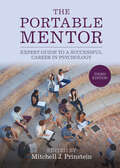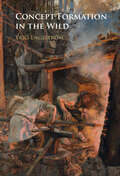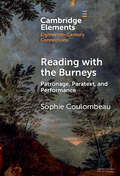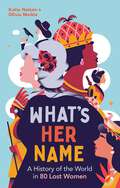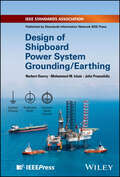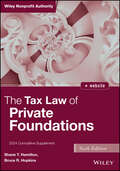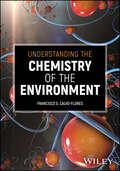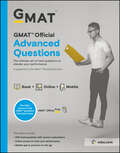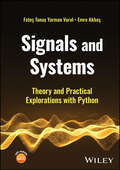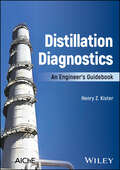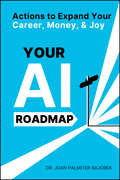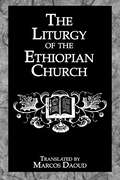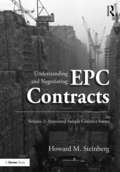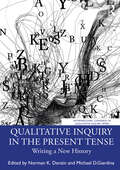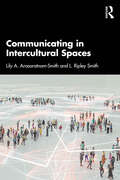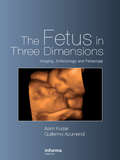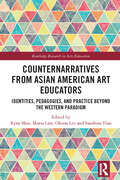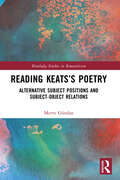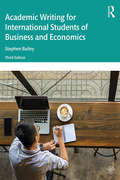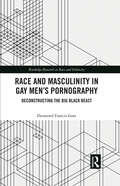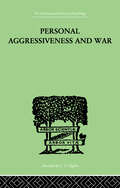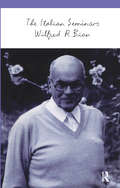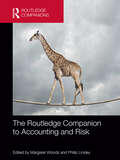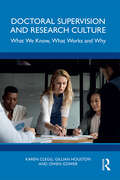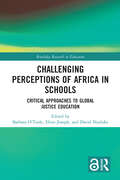- Table View
- List View
The Portable Mentor: Expert Guide to a Successful Career in Psychology
by Mitchell J. PrinsteinPsychology is a popular subject to study, with thousands entering graduate school each year, but unlike med or pre-law, there is limited information available to help students learn about the field, how to successfully apply, and how to thrive while completing doctoral work. The Portable Mentor is a useful, must-have resource for all students interested in psychology. This third edition is updated and expanded, designed to address students' and trainees' need for open dialogue and mentorship. Throughout, it covers some of the common challenges graduates face and features discussions about how to celebrate your identity and find a rewarding, worthwhile career path. It comprises thirty chapters written by more than seventy of the field's top experts, successfully filling a void in professional development advice.
Concept Formation in the Wild
by Yrjö EngeströmConcept formation is predominantly analyzed in classrooms and laboratory experiments, meaning the collective formation of culturally novel concepts in practical activities 'in the wild' has largely been neglected. However, understanding and influencing the complexity and contradictions of the present world demands powerful concepts that can make a difference in practice. Going beyond the understanding of concepts as individually acquired static labels, this book develops a dialectical theory of collective formation of novel concepts in the wild, in everyday activities. Drawing on cultural-historical activity theory (CHAT), concepts are seen as contested and future-oriented means for guiding activities and their transformations. Detailed real-life examples of germ-cell concepts show how they can radically influence the course of development in different activities. Helping to identify and foster the formation of potentially powerful concepts in fields of practice, it is essential reading for researchers, advanced students and practitioners across human and social sciences.
Reading with the Burneys: Patronage, Paratext, and Performance (Elements in Eighteenth-Century Connections)
by Sophie CoulombeauThis Element offers a multidimensional study of reading practice and sibling rivalry in late eighteenth-century Britain. The case study is the Aberdeen student and disgraced thief Charles Burney's treatment of Evelina (1778), the debut novel of his sister Frances Burney. Coulombeau uses Charles's manuscript poetry, letters, and marginalia, alongside illustrative prints and circulating library archives, to tell the story of how he attempted to control Evelina's reception in an effort to bolster his own socio-literary status. Uniting approaches drawn from literary studies, biography, bibliography, and the history of the book, the Element enriches scholarly understanding of the reception of Frances Burney's fiction, with broader implications for studies of gender, class, kinship and reading in this period. This title is also available as Open Access on Cambridge Core.
What's Her Name: A History of the World in 80 Lost Women
by Katie Nelson Olivia MeikleWhat if some of the most phenomenal lives in human history were, for centuries, forgotten? For centuries, the achievements of countless influential women have remained overshadowed. Sisters Katie Nelson and Olivia Meikle traverse hundreds of years and six continents, from antiquity to modern times, to turn the spotlight on these unsung heroines, revealing their stories and celebrating their indelible impact on the world. This mesmerizing compendium highlights the captivating stories of eighty women, including Fatima al-Fihri, the visionary behind the world’s first university; Ching Shih, the most successful pirate; and Huda Sha’arawi, a leading Egyptian suffragist. What’s Her Name is a compelling tribute to the indomitable spirit and contributions of these women who have shaped history—and deserve to be remembered and commemorated.
Design of Shipboard Power System Grounding / Earthing
by Mohammed M. Islam Norbert Doerry John ProusalidisThis book delves into the diverse prerequisites for grounding and earthing in contemporary ship power systems, addressing the evolving landscape of ship design influenced by power electronics The introduction of transformative technologies such as variable frequency drives and electric propulsion systems has heightened the complexity of shipboard grounding systems. This complexity necessitates accommodation for robust electronic systems, extending the focus beyond traditional grounding aspects to include common mode grounding and its profound design implications. Engineers now require a comprehensive guide to navigate the intricacies of shipboard electric power systems. To meet this imperative, Design of Shipboard Power System Grounding/Earthing provides an in-depth exploration of the subject. It offers a step-by-step initiation into the grounding process, supported by numerous case studies for enhanced comprehension. Aligned with both US and international standards, this book serves as an essential resource for engineers engaged in the design and implementation of shipboard power systems. Key highlights for readers encompass meticulous comparisons between terrestrial power system grounding and shipboard power grounding, as well as comprehensive discussions on high resistance grounding, shipboard AC system grounding requirements, DC system grounding, and more, including common mode grounding and earthing. The inclusion of abundant engineering drawings supports significant case studies, enhancing the practical application of the material. Designed to cater to a broad audience, Design of Shipboard Power System Grounding/Earthing is invaluable for readers involved with shipboard electrical systems, including shipbuilders, ship designers, ship operators, and those in regulatory bodies such as the Navy, USCG, ABS, among others. This resource is also well-suited for academicians, particularly final-year undergraduate and graduate students in marine electrical engineering programs.
The Tax Law of Private Foundations: 2024 Cumulative Supplement
by Bruce R. Hopkins Shane T. HamiltonInsightful analysis and explanations of private foundation tax law along with hands-on practice tools that make compliance easier Now in its seventh edition, The Tax Law of Private Foundations by Bruce Hopkins and Shane Hamilton serves as the gold-standard reference for navigating the complex regulations governing private foundations. This comprehensive book is regularly updated to incorporate the latest changes in tax law, providing executives and professionals with valuable clarification, expert insights, and practical instruction. With every edition supplemented annually, the book remains current and relevant. It offers a clear and concise summary of the regulations governing private foundations, explaining the logic underpinning the rules. The authors provide a range of helpful tools, including checklists, sample documents, and practice forms, to simplify the filing process and ensure compliance with the latest legislation. Readers will also find: Critical analyses and considerations of existing laws and regulations, avoiding potential confusion arising from future legislation A collection of practical tools that make it simpler to comply with the regulations governing private foundations Expert guidance on obtaining or maintaining your foundation's tax-exempt status An indispensable resource, this latest edition caters to individuals with personal or professional interests in private foundations, offering authoritative guidance and complete explanations in an intricate and sometimes confusing area of the law. Whether navigating the complexities of compliance or seeking deep insights, this book remains the go-to reference for understanding and managing this difficult area of taxation.
Understanding the Chemistry of the Environment
by Francisco G. Calvo-FloresUnderstand the properties and consequences of chemical pollutants Environmental chemistry is the field of study which focuses on chemical species, natural or man-made, and their impact on the atmosphere, water, and soils. It’s a growing area of research and technological development, increasingly prominent in university chemistry curricula. There is more demand than ever for a strong textbook overview of this thriving interdisciplinary subject and its myriad applications. Understanding the Chemistry of the Environment meets this demand with an exploration of the chemical aspects of pollution and its consequences. It offers a clear explanation of the relationship between chemical structure, physiochemical properties of natural and anthropogenic substances, and environmental impact. Drawing upon advances in chemistry, biochemistry, physics, engineering, toxicology, and more, it is a must-own for students and researchers in environmental chemistry. Understanding the Chemistry of the Environment readers will also find: Overview of major chemical pollutants and their ecotoxicological effects Understanding the Chemistry of the Environment is ideal for undergraduate students in environmental chemistry courses, as well as graduate students in need of a reference work on environmental chemistry.
GMAT Official Advanced Questions
by GMAC (Graduate Management Admission Council)GMAT Official Advanced Questions Your GMAT Official Prep collection of only hard GMAT questions from past exams. Bring your best on exam day by focusing on the hard GMAT questions to help improve your performance. Get 300 additional hard verbal and quantitative questions to supplement your GMAT Official Guide collection. GMAT Official Advance Questions: Specifically created for those who aspire to earn a top GMAT score and want additional prep. Expand your practice with 300 additional hard verbal and quantitative questions from past GMAT exams to help you perform at your best. Learn strategies to solve hard questions by reviewing answer explanations from subject matter experts. Organize your studying with practice questions grouped by fundamental skills Help increase your test-taking performance and confidence on exam day knowing you studied the hard GMAT questions. PLUS! Your purchase includes online resources to further your practice: Online Question Bank: Create your own practice sets online with the same questions in GMAT Official Advance Questions to focus your studying on specific fundamental skills. Mobile App: Access your Online Question Bank through the mobile app to never miss a moment of practice. Study on-the-go and sync with your other devices. Download the Online Question Bank once on your app and work offline. This product includes: print book with a unique access code and instructions to the Online Question Bank accessible via your computer and Mobile App.
Signals and Systems: Theory and Practical Explorations with Python
by Fatos Tunay Yarman Vural Emre AkbasIntroductory course textbook on signals and systems with numerous examples and code snippets implemented in Python Supported by code examples, Signals and Systems: Theory and Practical Explorations with Python is a textbook resource for a complete introductory course in systems and signals, enabling readers to run Python programs for convolution, discrete time Fourier transforms and series, sampling, and interpolation for a wide range of functions. Readers are guided step-by-step through basic differential equations, basic linear algebra, and calculus to ensure full comprehension of the exercises. This book is supported by a companion website, hosting interactive material to draw functions, and run programs in Python; it is enriched with audiovisual material via linking to related videos. Links to resources that provide a deeper explanation about the important concepts in the book, such as the systems approach, complex numbers, harmony, the Euler equation, and Hilbert spaces, are also included. Written by two highly qualified academics, topics covered include: Systems approach for modeling the natural and manmade systems and some application areas Representation of complex and real signals by basic functions, such as real and complex exponentials, unit step and unit impulse functions Properties of signals, such as symmetry, harmony, energy, power, continuity and discreteness Convolution and correlation operations for continuous time and discrete time signals and systems Representation of systems by impulse response, frequency response, transfer function, block diagram, differential and difference equations Properties of systems, such as linearity, time invariance, memory, invertibility, stability and causality Continuous time and discrete time Fourier analysis in Hilbert space and their extension to Laplaca transform and z-transform Filtering by Linear Time Invariant systems in time and frequency domains, covering low pass, high pass band pass and band reject filters Sampling theorems for continuous time and discrete time systems, covering A/D and D/A conversion, sampling and interpolation Signals and Systems is an ideal textbook resource for a one semester introductory course on signals and systems for upper level undergraduate and graduate students in computer science, electrical engineering and data science. It is also a useful reference for professionals working in bioinformatics, robotics, remote sensing, and related fields.
Distillation Diagnostics: An Engineer's Guidebook
by Henry Z. KisterThorough guide on how to use various diagnostic techniques to troubleshoot problems in distillation columns Distillation Diagnostics familiarizes the reader with the multitude of tools available for diagnosing distillation and absorption tower problems and provides the reader with application guidelines derived from 40+ years of real-world experiences of the author. The book describes the capabilities, strengths and limitations of each tool, provides guidance on how to apply these tools to get the most insight and to test theories and ideas, shares the experience of how to correctly interpret the results provided by each technique, and guides the reader to a multitude of additional testing that they can perform to bring them closer to a correct diagnosis and an effective fix. Each technique is illustrated with real case studies and an extensive “dos and don’ts” list. Written by a global authority on distillation diagnostics and troubleshooting known as ‘The Tower Doctor’ by many in the field, Distillation Diagnostics includes information on: Possible solutions to the growing distillation failure rate despite the tremendous recent advances in distillation technologies Time-tested tools and techniques for correctly diagnosing distillation problems to provide simple low-cost fixes instead of unnecessary wasteful solutions, thus eliminating waste and dramatically reducing CAPEX, energy consumption and carbon footprint Combining the various diagnostic techniques to discard wrong theories and narrow in on the correct root cause and proper solution for various tower malfunctions Diagnosing flooding, foaming, plugging, weeping, maldistribution, channeling, distributor and collector overflows, low efficiencies, feeds and draws bottlenecks, assembly mishaps, tower internals damage, high base level issues, reactions in towers, contaminants, internal and external leaks, startup and/or shutdown difficulties Correctly interpreting gamma scan, thermal scan, and pressure drop data Getting the most out of testing techniques such as gamma scanning, neutron backscatter, wall temperature surveys, pressure drop measurements, column testing, sketching points of transition, collecting data for simulations, conducting mass and energy balances, analyzing operating charts, and in-situ water testing Turnaround tower inspections: what to look for Advanced gamma scanning and thermal scanning techniques and when to apply The “doctor and patient” troubleshooting strategy, which often constitutes the most effective, most systematic, and least expensive course of action Things to remember when formulating and testing theories, such as the balance between theory, data, the laws of physics, and chemistry Distillation Diagnostics is a timely, essential reference on the subject for plant managers and operators, production and startup supervisors, and chemical, process, and design engineers.
Your AI Roadmap: Actions to Expand Your Career, Money, and Joy
by Joan Palmiter BajorekAs seen at VentureBeat, CES, and in Harvard Business Review A pesky truth of the age of AI is that everyone's day job is at risk, but we all still need money. We all need to future-proof our careers and finances ASAP. Your AI Roadmap is not just an advice book, it's a modern blueprint for your career and income. One part modern careers and one part wealth building, this book is ready to take you on an adventure! You will never be truly free, stable, and at peace until your financial house is in order. If AI takes a huge number of jobs in the next few years, jumping from job to job won't future-proof your income and provide stability. You need to have your own money, in your own name, in your own accounts. With humor and data-driven examples, Joan provides fresh and tactical career advice as well as ways to expand your income to get your finances in order in the era of AI. Serial entrepreneur, investor, and AI influencer, Dr. Joan Palmiter Bajorek is a global leader in AI. She has served as CEO, President, VP, advisor, and senior roles at AI startups and enterprises including Clarity AI, Nuance, VERSA, and Edward Lifesciences. Joan is the Founder of Women in Voice, 501(c)(3). She is the CEO of Clarity AI creating custom AI and data products. She is the host of the Your AI Roadmap Podcast where she has interviewed top executives from Google, Microsoft, Amazon, and more to discuss their projects and careers: YourAIRoadmap.com To be clear: Joan is not satisfied with knowing how to build wealth herself. Everyone deserves a financial education and to know that through the age of AI that they can take care of themselves. Let's talk about careers and money! But Joan's AI career hasn't always been smooth sailing. Joan has lost her job in two large-scale AI layoffs. That hasn't stopped her! Being entrepreneurial is key to Joan's financial resilience on her way to financial independence. Playful, inclusive, and poignant, this book provides personal and professional guidance for people just launching their careers and for people well on their way. The book offers: Goal Setting: Set your goals in a clinically validated way via the WOOP method Storytelling: Owning your story and accomplishments via the STAR method to connect the dots for listeners Personal Brand: Steps to build, grow, and optimize your professional presence online Networking: Modern, people-first techniques to expand your network with coffee chats Joan's 3 Step Recipe for Financial Freedom Recipe: Know, grow, and be in control of your finances Income Streams and Diversification: Joan shares her 22 revenue streams to build her net worth Wealth Expansion: 5 Simple Steps to launch a Basic Offer PSS 3-Step Framework to Expand Your Income to $1M in revenue Income Streams: 57 income stream ideas to try out from easy to advanced difficulty Inspiration: Joy, confidence, and meaning in your next steps to craft your own AI roadmap! Perfect for anyone dreaming about AI, careers, and future-proofed finances from the classroom to the board room, including college grads, executives, pivoters, managers, directors, investors, founders, entrepreneurs, parents, and career counselors. Your AI Roadmap is your guide through the age of AI to future-proof your career and income.
Liturgy Ethiopian Church
by Marcos DaoudFirst published in 2005. Originally, the Ethiopian Church received fourteen Anaphora’s from the Church of Egypt, yet at the time of publication, only three of them could be accounted for- that of St. Cyril, St. Gregory and St. Basil. Marcos Daoud has therefore devoted this work to the English translation of the remaining three.
Understanding and Negotiating EPC Contracts, Volume 2: Annotated Sample Contract Forms
by Howard M. SteinbergAny project which involves an EPC contract is also likely to involve a number of other complicated contracts. The challenge of the parties to an EPC contract is not to try to eliminate risk but rather put into place a narrative structure that enables the parties to predict the contractual result that would obtain if a risk materializes. If the EPC contract does not allow the parties to determine the consequences of an unanticipated situation, they will have to look to an expert, mediator, tribunal, or court to impart guidance or pass judgment. The sample forms of contract contained in Volume 2 of Understanding and Negotiating EPC Contracts are intended to serve as a guide to demonstrate how risks and responsibilities can be allocated among project sponsors, EPC contractors and the various other parties that may be involved in a project. Collectively the sample forms in this volume offer an extraordinary resource that provides the benefit of lessons learned and priceless insight into any project being undertaken which can help assure the resilience of any EPC project.
Qualitative Inquiry in the Present Tense: Writing a New History (International Congress of Qualitative Inquiry Series)
by Norman K. Denzin Michael D. GiardinaIn Qualitative Inquiry in the Present Tense, contributors engage with epistemological and philosophical questions concerning the conduct of qualitative inquiry in the present moment, and especially as it relates to various understandings of writing in/as inquiry.Topics addressed include methodological processes, questions of narrative uprootedness, relational inquiry, Indigenous ethico-onto-epistemologies, storytelling, and transformative writing forms and practices. This is a messy, often unruly collection (in the best way possible) of disparate ideas strung tightly together by literal and metaphorical questions of the research act of writing. Contributors from the United States, Australia, Canada, England, and Scotland imaginatively conceive of new qualitative futures—and how we might write ourselves there.This evocative new book is a must-read for faculty and students alike who are interested in and engaged with questions and ideas oriented toward understanding our current historical present in qualitative research—a moment in which the field is perpetually in motion or in flux, with new theories, methods, and orientations arising, competing, and even contradicting one another.
Communicating in Intercultural Spaces
by Lily A. Arasaratnam-Smith L. Ripley SmithCommunicating in Intercultural Spaces is a unique contribution to literature in intercultural communication from two authors who bring distinct socio-cultural voices to this work. Written for readers ranging from advanced undergraduate students to intercultural practitioners, this book offers a new conceptualisation for understanding intercultural communication. Eight propositions frame the concept of intercultural spaces.Grounding the discussion on the framing of intercultural spaces, the authors engage with a range of topics such as perception, language, acculturation, and intercultural competence, couched in original personal narratives from 21 leading intercultural scholars. The narratives and vignettes add vibrant context to the scholars’ works that are cited in this book. The book also delves into the origins of intercultural communication as a discipline and the dark side of communicating across differences. Each chapter ends with a brief dialogue between the authors, followed by questions for stimulating further reflection.Readers should expect to walk away with an understanding of key theories and frameworks in intercultural communication and the tools with which to develop their own intercultural communication competence.
The Fetus in Three Dimensions: Imaging, Embryology and Fetoscopy
by Asim Kurjak Zagreb CroatiaFor the ultrasound practitioner it is now more important than ever to have a rigorous understanding of fetal anatomy and development. This Atlas publishes a selection of very high-quality ultrasound images of the fetus alongside embryological preparations and fetoscopy images. This unique comparative technique will be an essential educational tool and work of reference for all involved in fetal ultrasound.
Counternarratives from Asian American Art Educators: Identities, Pedagogies, and Practice beyond the Western Paradigm (Routledge Research in Arts Education)
by Ryan Shin Maria Lim Oksun Lee Sandrine HanCounternarratives from Asian American Art Educators: Identities, Pedagogies, and Practice beyond the Western Paradigm collects and explores the professional and pedagogical narratives of Asian art educators and researchers in North America. Few studies published since the substantial immigration of Asian art educators to the United States in the 1990s have addressed their professional identities in higher education, K-12, and museum contexts. By foregrounding narratives from Asian American arts educators within these settings, this edited volume enacts a critical shift from Western, Eurocentric perspectives to the unique contributions of Asian American practitioners.Enhanced by the application of the AsianCrit framework and theories of intersectionality, positionality, decolonization, and allyship, these original contributor counternarratives focus on professional and pedagogical discourses and practices that support Asian American identity development and practice. A significant contribution to the field of art education, this book highlights the voices and experiences of Asian art educators and serves as an ideal scholarly resource for exploring their identity formation, construction, and development of a historically underrepresented minoritized group in North America.
Reading Keats’s Poetry: Alternative Subject Positions and Subject-Object Relations (Routledge Studies in Romanticism)
by Merve GündayThis book claims that Keats’s poetry is a reaction against the discourse of modernity which traumatized the human subject by creating a divide between human and nature, subject and object. It argues that by transcending this divide and acknowledging the agency of both subject and object, Keats makes an ideological statement and offers a new site of existence or relationality to readers. This site also implies a response to the accusations that the Romantics were not interested in the realities of their time. What Keats does is to give an aestheticized response to the hardcore facts of his time. Departing from previous studies due to its emphasis on subjectivity and relationality, the book discusses Keats with regard to post/non-anthropocentric, alternative subject positions and subject-object relations in his “Ode to a Nightingale,” “In drear nighted December,” “Isabella; or, The Pot of Basil,” “Lamia,” “La Belle Dame sans Mercy,” and “Ode on a Grecian Urn.” Drawing on Lacanian and Braidottian epistemologies in its discussion of the intricacy between the imaginary and the symbolic, the irruption of the psychotic into the symbolic, and the agency of the object on the subject in Keats’s poetry, the book suggests that the inner dynamics of both the subject and the object acquire agency, which shatters Oneness and totality assumed in the Cartesian self.
Academic Writing for International Students of Business and Economics
by Stephen BaileyThe third edition of Academic Writing for International Students of Business and Economics is written to help international students succeed in writing essays, reports and other papers for their English-language academic courses. Thoroughly revised and updated to reflect issues such as diversity and sustainability, this book is designed to let students and teachers easily find the help they need, both in the classroom and for self-study.The book is divided into five parts, comprising a total of 42 units: The Writing Process Elements of Writing Language Issues Vocabulary for Writing Writing Models New topics in this edition include Writing in Groups, Written British and American English and Reflective Writing. In addition, the new interactive website has a full set of teaching notes as well as more challenging exercises, revision material and links to other sources. Additional features of the book include: Models provided for writing tasks such as case studies and literature reviews Use of authentic academic texts from a range of sources Designed for self-study as well as classroom use Useful at both undergraduate and postgraduate level A complete set of answers to the practice exercises Cross-references across all units Providing a glossary to explain technical terms and written to deal with the specific language issues faced by international students of Business and Economics, this practical, user-friendly book is an invaluable guide to academic writing in English.
Race and Masculinity in Gay Men’s Pornography: Deconstructing the Big Black Beast (Routledge Research in Race and Ethnicity)
by Desmond Francis GossThis book unpacks the character of pornographic representations of queer Black masculinity and how these representations vary between corporate and noncorporate producers. The author argues that representations of Black men in gay porn rely on stereotypes of Black masculinity to arouse consumers, especially those which characterize Black men as "missing links" or focus excessively on their "dark phalluses." Moreover, these depictions consistently separate gay Black and white men’s sexuality into bifurcated discursive spaces, thereby essentializing sexual aspects of racial identity. Lastly, though such depictions are less prevalent in user-submitted videos, overall, both user-submitted and corporate content reify stereotypes about Black masculinity. This book is written for researchers, lecturers, and graduate courses in the social sciences and humanities, including Sociology, Social Psychology, Sexuality, African American Studies, Women and Gender Studies, LGBTQ Studies, Culture and Art Studies, Porn Studies, Social Media Studies, and Public Health.
Personal Aggressiveness and War
by E F DurbinThis is Volume I of seven in the Social Psychology series. First published in 1949, from a symposium entitled 'War and Democracy' this essay presents an introduction to the scientific study of the causes of fighting and war. It offers an attempt to describe and analyse the general psychological forces lying behind the timeless and ubiquitous urge to fight and kill.
The Italian Seminars
by Wilfred R. BionThe Italian Seminars, previously unpublished in English, comprises lectures W.R. Bion gave in Rome, in 1977. The volume consists of questions from the floor and Bion's fascinating and, at times, controversial answers. The lectures are divided in two: the first part was organized by the Italian Psychoanalytical Society and the second by the Via Pollaiolo Research Group. Bion's replies examine such diverse subjects as difficulties in the interaction between the therapist and the patient; music and psychoanalysis; non-verbal communication in the consulting room; and methodology in psychoanalysis.
The Routledge Companion to Accounting and Risk (Routledge Companions in Business, Management and Marketing)
by Margaret Woods Philip LinsleyTo date, there has been little consideration of the many different ways in which accounting and risk intersect, despite organisations being more determined than ever to build resilience against potential risks. This comprehensive volume overcomes this gap by providing an overview of the field, drawing together current knowledge of risk in a wide range of different accounting contexts.Key themes such as corporate governance, trust, uncertainty and climate change are covered by a global array of contributing scholars. These contributions are divided into four areas: The broader aspects of risk and risk management Risk in financial reporting Risk in management accounting Risk monitoring The book is supported by a series of illustrative case studies which help to bring together theory and practice. With its wealth of examples and analyses, this volume provides essential reading for students, scholars and practitioners charged with understanding diverse facets of risk in the context of accounting in the business world.
Doctoral Supervision and Research Culture: What We Know, What Works and Why
by Karen Clegg Gillian Houston Owen GowerDrawing on original survey data, reflective accounts, and case studies of supervisory practice in different disciplines, Doctoral Supervision and Research Culture explores the supervisor experience and demonstrates the craft, compassion and consistency required of supervisors in responding to different researcher’s needs.Based on empirical data and using the voice of research supervisors, the authors throw a spotlight on the challenges and opportunities supervisors face in supporting doctoral researchers through to successful PhD completion. This book acts as an invitation to institutions, funders, industry and academics to review what, and how they support PhD provision and to elevate the status of supervision practice. It shows how research cultures - disciplinary, institutional and individual - affect the supervisory experience and highlight the challenges that supervisors face, as well as the rewards that successful supervisory relationships bring. It is also a celebration of the contribution that doctoral researchers and all those who support research make to society. Designed to provide opportunities for sharing of practice across disciplines and the sector, Doctoral Supervision and Research Culture will be of interest to both new and experienced supervisors, to staff and researcher developers in institutions, and to funders, policy makers and senior management in universities who seek to improve and enhance the supervisory experience for all agents.
Challenging Perceptions of Africa in Schools: Critical Approaches to Global Justice Education (Routledge Research in Education)
by Ebun Joseph David Nyaluke Barbara O'TooleThis book challenges educational discourse in relation to teaching about Africa at all levels of the education system in the Global North, with a specific case study focusing on the Republic of Ireland. The book provides an interrogation of the proliferation of negative imagery of and messages about African people and African countries and the impact of this on the attitudes and perceptions of children and young people. It explores how predominantly negative stereotyping can be challenged in classrooms through an educational approach grounded in principles of solidarity, interdependence, and social justice.The book focuses on the premise that existing educational narratives about the African continent and African people are rooted in a preponderance of racialised perceptions: an ‘impoverished’ continent dependent on the ‘benevolence’ of the North. The cycle of negativity engendered as a result of such portrayals cannot be broken until educators engage with these matters and bring critical and inquiry-based pedagogies into classrooms. Insights into three key pedagogical areas are provided – active unlearning, translating critical thinking into meaningful action, and developing a race consciousness.This book will appeal to academics, researchers, and post-graduate students in the fields of education and teacher education. It will be of interest to those involved in youth work, as well as intercultural and global citizenship youth trainers.The Open Access version of this book, available at http://www.taylorfrancis.com, has been made available under a Creative Commons Attribution-Non Commercial-No Derivatives (CC-BY-NC-ND) 4.0 license.
